Kochia plant: simplicity and grandeur
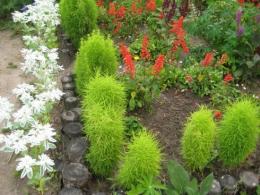
This plant, reminiscent of a miniature shrub, has been decorating our front gardens not so long ago. But it has already become familiar in our landscape. As it turns out, the kochia plant not only looks beautiful, but also brings many benefits.
Content:
What are the benefits of kochia?
The name of the plant was given in honor of the botanist Wilhelm Koch. The natural habitat of kochia is located in Transbaikalia and the Altai Territory. This annual plant has a very branched stem. Its height can reach even one meter.
On the stem pyramid shaped small thin leaves and equally small flowers are crowded into a fluffy ball. Small, inconspicuous kochia flowers bloom in the leaf axil. These single inflorescences manage to give the plant a sophisticated look. The flowering period of the plant is from July to October.
The greenery of the kochia plant contains a lot of:
- saponins
- organic acids
- tannins
- steroids
- coumarins
- alkaloids
- flavonoids
- betaine in branches
- vegetable oils - in fruits
With the help of kochia, fever and itching are reduced. The infusion of this herb contains tonic substances that also have a diaphoretic effect. Kochia is used for heart diseases. It also acts as a laxative.
A decoction of kochia seeds and fruits is used to obtain a diuretic effect. It also has a stimulating effect on the human body. Kochia is often credited as a good remedy for the external treatment of various skin problems.
Due to the significant protein content in the plant, in places where it grows naturally it is a promising crop used as animal feed. In addition to the abundance of nutrients, this is facilitated by a long growing season, good yield and drought resistance.
Those who have experienced the beneficial properties of kochia are happy to share their positive impressions about this plant. And if someone has not had to do this yet, then they can take their experience into their arsenal.
Application of kochia

The kochia plant is rightfully considered to have a beneficial effect on the human body. Both folk and traditional medicine recommend the use of kochia for diseases of the urinary system, rheumatism and severe edema.
As a powerful dermatological drug, medicines from kochia are indicated for eczema, erysipelas and other skin inflammations. A number of effective ointments from kochia have been created for dermatitis.
Freshly picked kochia leaves added to various dishes to improve their taste and greater benefits. To prepare the infusion, take dry kochia herb (10 g) and mix with boiling water (1 cup). The composition is taken internally at a dose of 50 milliliters 3 times a day for various inflammations. It is recommended to use a decoction of the fruits of this plant to treat even gonorrhea and problems with urinary tract.
Kochia is used as a tapeworm - a single plant. It also emphasizes group plantings in an original way. The kochia plant is appropriate in a mixed garden and is indispensable as a background for other flowers.
The only drawback of kochia is that it cannot be grown as a houseplant. This is because she doesn't like confined spaces. This causes the plant in the pot to become frail and faded.Also, in a flowerpot, it goes into autumn withering conditions earlier than expected, turning red prematurely.
In indoor conditions, kochia is very susceptible to attack by spider mites. Under its influence, the bush becomes less decorative. Gradually completely fading. You can, of course, use special preparations, but it is better to leave the kochia to grow in natural conditions.
In the poor conditions of desert and semi-desert with their cold, snowless winters or in a sharply continental climate, such a persistent representative of the flora is simply irreplaceable. It is valued here not only as a fodder and medicinal plant, but also as an ornamental crop.
Kochia in its natural range is used as a ground cover. perennial. In the driest open places, it is used to decorate rocky hills, flower beds completely open to the sun, and also to zone the territory of the site with curly borders made of kochia.
To correctly position this plant among other flowers, you should take into account its height and width. And if kochia bushes are planted as a hedge, then their size can be easily adjusted. Truly: both convenient and beautiful!
Varieties of kochia
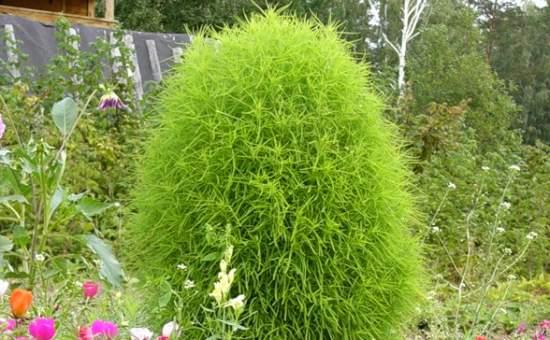
In our floriculture, we mainly deal with the two most common types of kochia: broom and hairy. The homeland of hairy kochia is China. This annual herbaceous plant easily forms a tall, dense, lush crown and reaches a height of more than a meter.
Small leaves of a soft green hue have inconspicuous flowers. Reproduction of this type of kochia occurs by seeds. This variety is drought-resistant and undemanding in care. Such kochia quickly grow and develop in fertile, moist soils, mainly on the sunny side.
The next type of kochia is broom.It is also quite unpretentious: it can easily withstand drought, and in the summer it can go without watering for a long time. This bush can be shaped in different ways at your discretion. In favorable conditions, representatives of coronoid cochia can reach more than a meter in height.
In autumn, the colors of the plant become more saturated. It withstands light frosts, but cannot survive our winters in the open ground. The best place for growing kochia is a well-lit, cozy place with soil rich in nutrients.
For reproduction The seeds of this spectacular plant are used. Their germination capacity, if properly stored, remains suitable for about six years.
It is noteworthy that previously, in places of natural growth, kochia was grown for technical purposes - for brooms, which is confirmed by the name of the variety. However, today broom kochia is a full-fledged ornamental plant
Master gardeners are able to make any of the most bizarre figures out of this shaggy bush, at least a ball, cube or hedge. In summer, bushes of light green, green with yellow, green with a bluish tint, and dark green color become orange, bright red or purple closer to autumn. And what’s especially nice is that no one knows in advance what color the kochia will turn out to be.
Entire glades in Japanese gardens covered with red kochia or, as it is called here, summer cypress, are simply impressive. A whole sea of red subshrubs covers vast areas, creating an unusually spectacular spectacle. Photographers love this time very much and capture it for the audience.
And to witness such beauty yourself, you don’t have to go to distant Japan.It is enough to plant kochia on your site and you can admire the color performances from early spring until late autumn.
Watch the video about the border kochia bush:
Interesting information about the vegetable garden

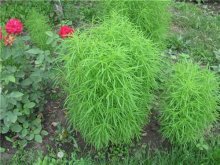
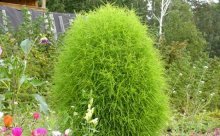
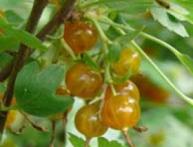
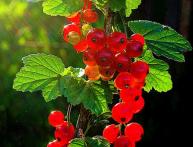
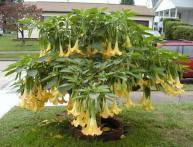
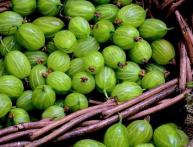

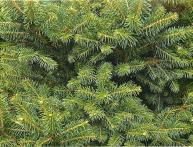
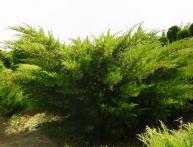
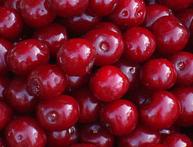
Comments
The main advantage of such a plant is its decorative functions; once it is sown, several more bushes will grow in the same place the next year. Kochia generally reproduces well, although it is considered an annual plant. But it has been tested in practice. It takes 3–4 years to grow.